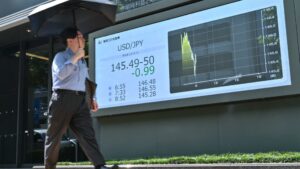Discover the Hidden World of the Yen Carry Trade
Have you ever heard of the yen carry trade? If not, you are not alone. This obscure yet powerful trading strategy has been a driving force behind the recent volatility in the Nikkei 225 stock market index. In fact, the Nikkei 225 saw a massive drop of 12% on Monday, only to recover by 10.2% the following day.
But what exactly is the yen carry trade, and why does it have such a significant impact on global markets? Let’s dive deeper into this complex yet fascinating concept.
At its core, the yen carry trade involves investors borrowing cheap yen to invest in higher-yielding assets, such as currencies or equities. When interest rate differentials between countries are favorable, this trade can seem like a surefire way to make easy profits. However, as we have witnessed recently, things can go south very quickly if interest rates change.
One of the key issues with the yen carry trade is its opacity. There is no central source to track currency trades, so the true size and scope of this practice remain unknown. Japanese banks’ foreign lending reached a staggering $1 trillion in March, up 21% from the previous year, highlighting the magnitude of this phenomenon.
But how does the yen carry trade actually work? Imagine a hedge fund borrowing 10 million yen at near-zero interest rates and using it to purchase U.S. dollars at a favorable exchange rate. While this may initially seem like a lucrative opportunity, any fluctuations in the yen’s value can quickly erode profits and lead to significant losses.
Furthermore, much of the yen carry trade is executed on margin, meaning hedge funds are borrowing large sums of money to amplify their potential gains (and losses). When the value of their investments starts to decline, brokers may issue margin calls, forcing funds to deposit more funds or sell off their assets.
The implications of the yen carry trade extend far beyond Japanese markets. Flows of capital driven by this practice can have a profound impact on global equity markets, including the U.S. stock market. As the yen continues to fluctuate, investors must remain vigilant and monitor key indicators like the Invesco Japanese Yen ETF (FXY) for potential signals of market turbulence.
In conclusion, the yen carry trade is a fascinating yet enigmatic force that shapes the dynamics of international finance. Understanding its mechanics and implications can help investors navigate choppy waters and make informed decisions in an ever-changing market landscape. Stay tuned to Extreme Investor Network for more cutting-edge insights and analysis on the latest trends in trading and investments.
In the world of finance, knowledge is power. Stay informed, stay ahead.

